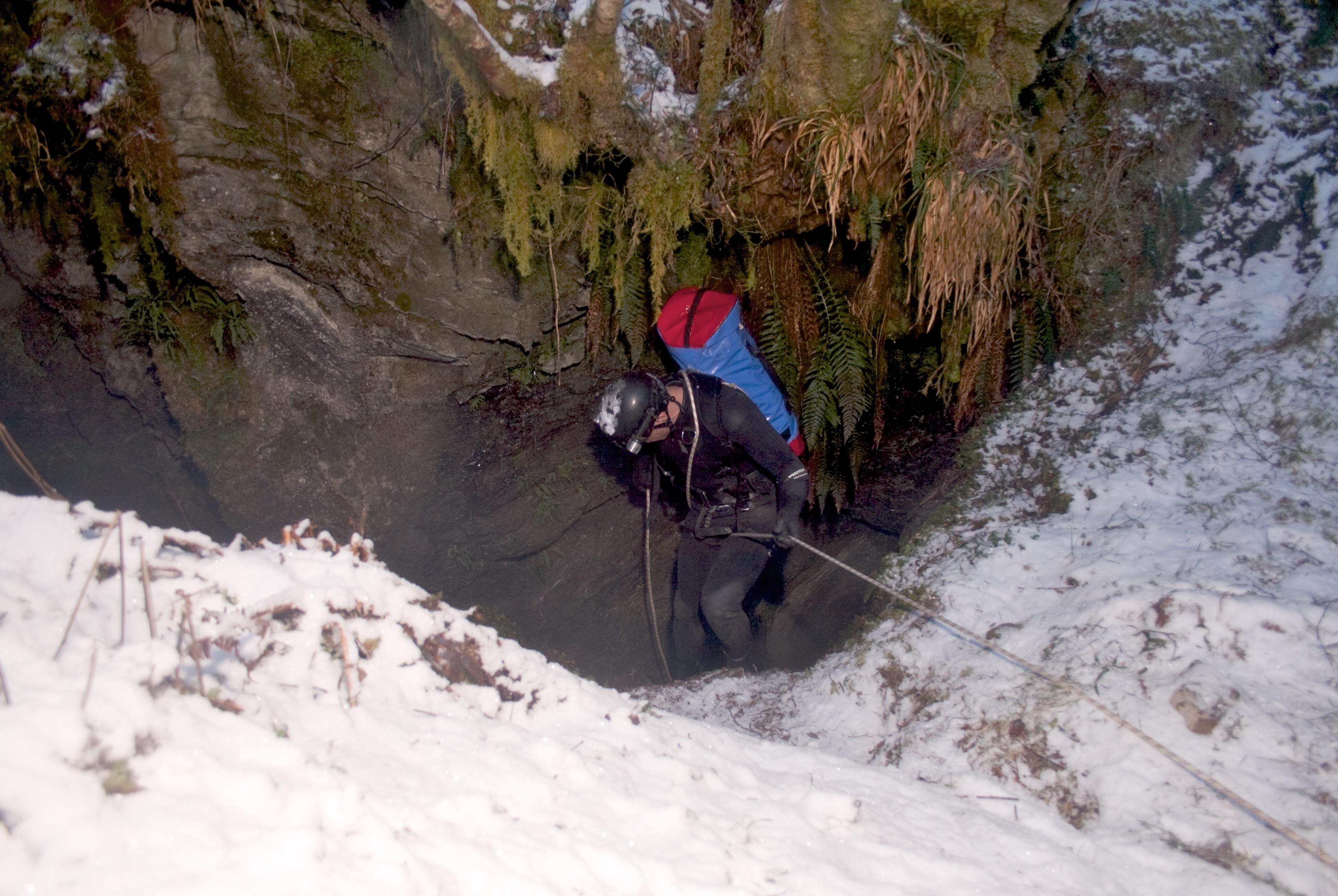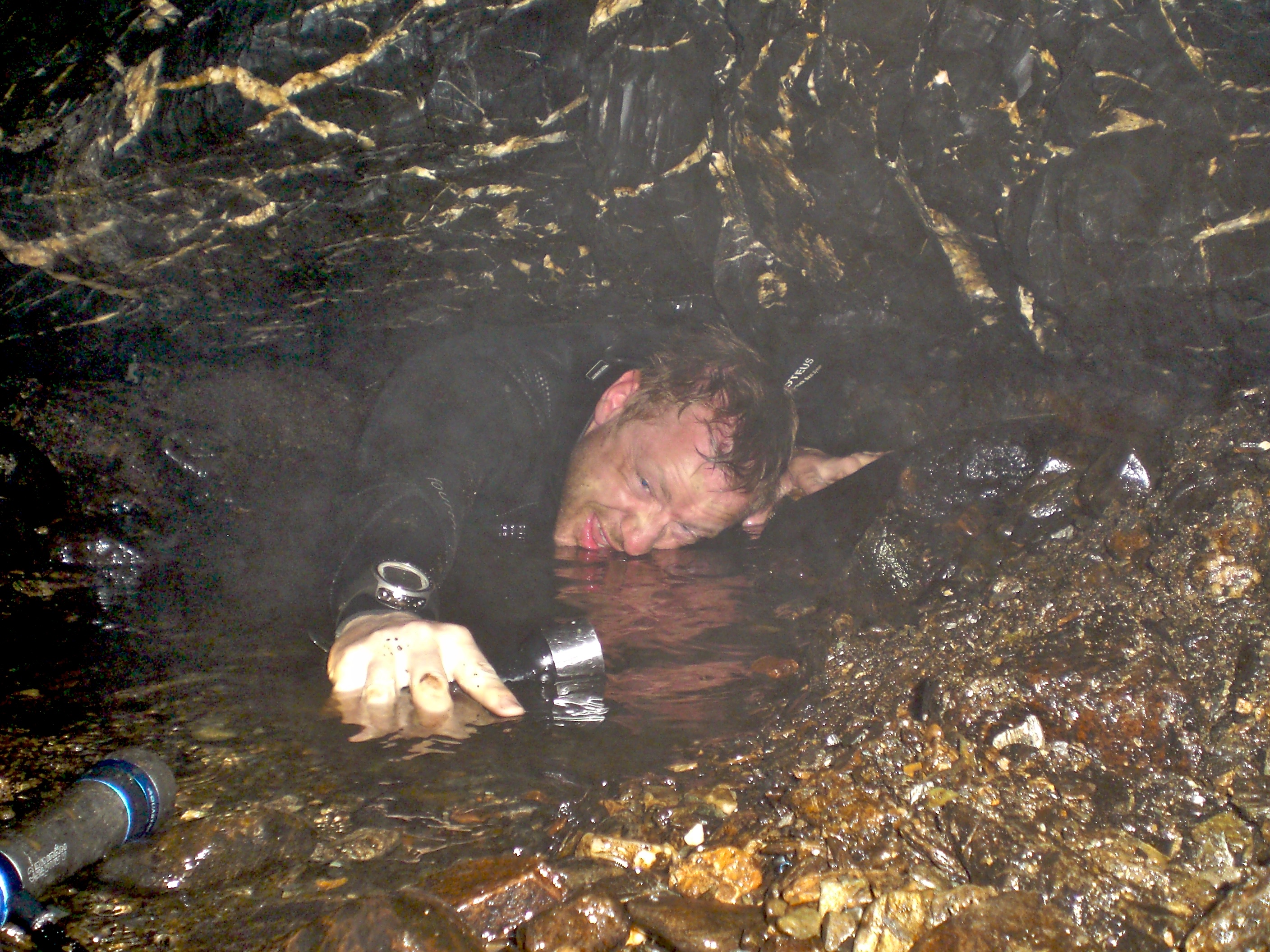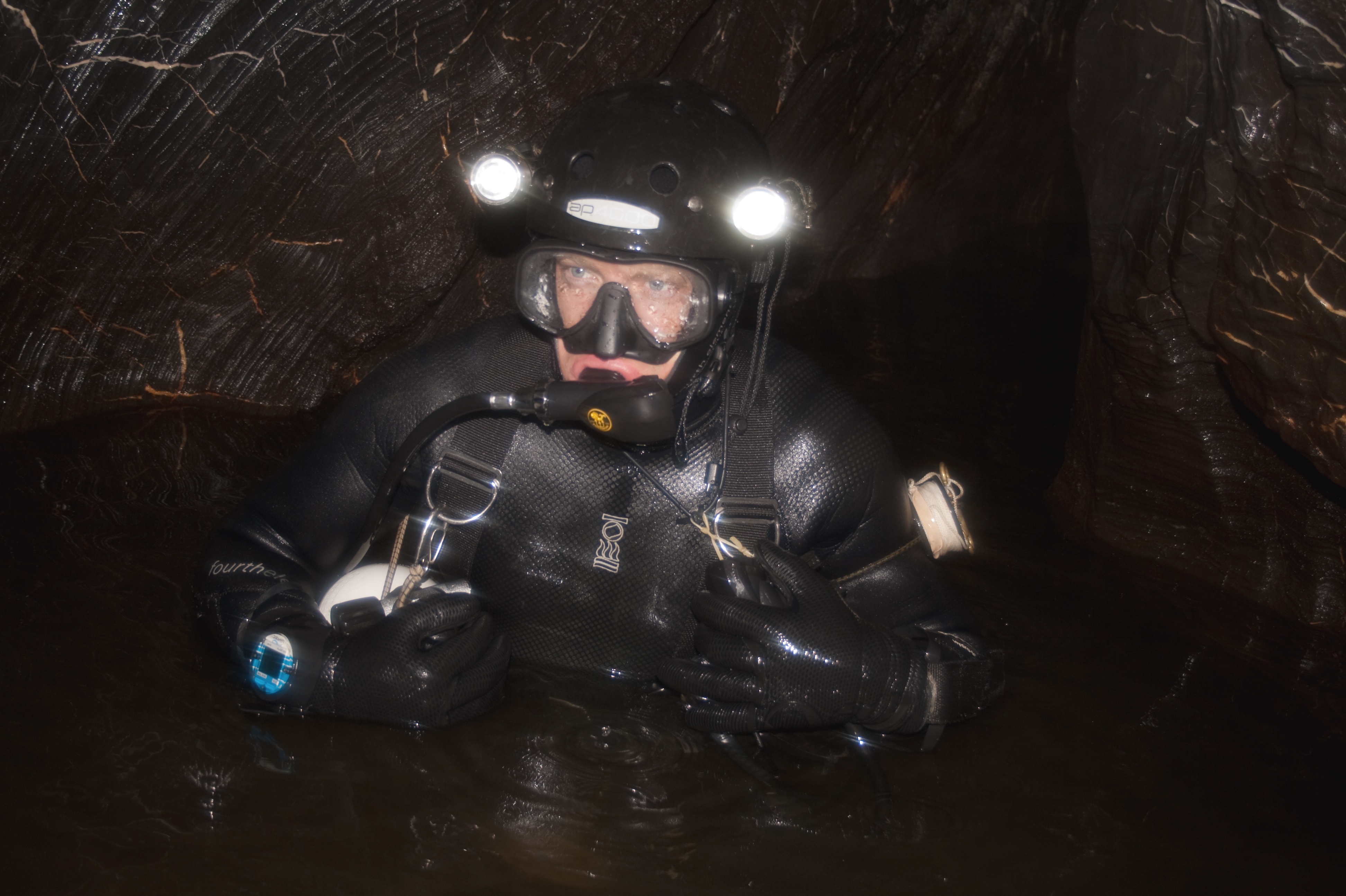News
Andy Torbet and the Cave of Skulls

The depth of a Highland Winter may seem an ill-advised time to embark on exploring the submerged passages of Uamh nan-Claigg ionn, The Cave of Skulls, Scotland’s deepest cave. But I had a lull in my diary; and besides, after dragging my kit down five vertical drops and numerous constricted crawls, I’d be convincingly ‘out of the wind’.
Cave diving in Scotland is like most of the UK, specialising in tight, serpentine crawls, long abseils and muddy water (or watery mud)… and the sites are normally a bloody a long way from the car. There aren’t many fat UK cave divers.
We were filming this little jaunt for the BBC’s Adventure Show. The plan was for Stu Keasley to film me up top and in the initial section, and I’d self-shoot on a small hand-held inside the rest of the system. I had to carry one of the heaviest rucksacks of my life – twin seven litre cylinder, side-mount harness, climbing harness, 105 metres of rope, torches, reels, abseiling, ascending and anchoring kit, and my camera – about 60kg in all. Fortunately it was only about a mile and a half from the end of the nearest road; unfortunately it was winter, the road was blocked, so it was two and half… uphill.
I’d investigated a few other sites the day before so, after Sherpa-ing my load up through the snow, I was gifted the opportunity to pull on a partially frozen wetsuit whilst simultaneously blaspheming enough to offend most major religions. Finally kitted up it was time to descend into the underworld. The entrance is large cavity in the ground, overarched by an eldritch, gnarled tree with beards and bunting of moss and lichen hanging into the icicle-encrusted darkness. Once I abseiled down and entered the system I could feel the rise in temperature as the warm earth enveloped me. The first awkward bend and low crawl brought the reality of my predicament. It was impossible to drag or push all my equipment in one go so I’d have to shuttle, re-doing each section four or five times. The first crawl is followed by two abseils, with one the most awkward take-offs I’ve ever encountered.
Up to this point it had been narrow rifts, low crawls and small spaces. That all changed after the second abseil. I sidled through a narrow crack and stepped out into an immense cavern; standing on a boulder-strewn ledge half way up its walls. The roof soared above me, tapering to a point, as the ground fell away into a shallow plunge pool. Anchoring the rope and strapping all my kit on, I swung out into the abyss. I find myself abseiling on a near-weekly basis but never with this much weight on. I treble-checked the anchor points before I took a deep breath and that first small step…
This vertical descent was followed by the House of Cards, so called because slabs of rock, shaped like giant playing cards, have fallen from above and become precariously wedged against one and other at convoluted angles leaving only a low, narrow space beneath. As I heaved and slithered through the gravel and water I kept reminding myself that the chaotic structure above me had probably stood for centuries and wasn’t likely to move anytime soon… (”are you sure?” said the voice in my head. “Besides Torbet,” he went on, “I’m no expert in geology, so neither are you”).
Safely through, and having shuttled all the kit, I came to the last two abseils. Not the longest, but the most fun. The first was down a short waterfall into a thigh-deep plunge pool and the second has you lowering yourself down through an hourglass effect. It starts spacious enough before narrowing to a point where you’re forced to turn your head to the side and bounce to get your chest and backside through before flaring out wide again. Finally you reach the bottom of the cave; but, if you’re a diver, not the end.
To reach the first sump required me to slide through an extremely low crawl. Unfortunately this had been made considerably tighter by the gravel, silt and debris washed in over the winter. The height was less than 25 cm and water covered the lower 15… and I am not built to cave. Too many years rock-climbing and carrying large rucksacks up large hills means I don’t possess the wiry, whippet, racing snake physique of the hardened caver… so I got stuck. Wriggling my way backwards I began excavating some of the larger rocks and gravel, trying to plough a furrow deep enough for me to squeeze myself through. With people waiting for me at the surface and overdue on my return time I had to leave, having failed to even reach the dive site. Morale was low. It was not aided by the thought of having to haul myself, and all that kit, back out of this hole.
On reaching the surface I was exhausted, and the effort of bring up all the equipment on my own had done little to improve my mood. I had said I would dive the limits of the deepest cave in Scotland. Failure.
Fast forward to June. Having driven through the night I find myself kitted up at the entrance once again. Alone this time with no cameras or filming to slow me down. I’ve exchanged my twin sevens for twin threes. I have one day; this will be like an alpinist ascent – fast and light. Knowing the layout and with only myself to worry about, I fly through the cave and am at the passage that stopped me last time. I dig and try to push through but keep getting stuck. I have to back out, dig more and try again. Each time the cold water burns my ears as I twist my head from side to side trying to breathe. Finally I can see the end; I’m sure I’ve done enough and force my way on. Inches from where the crawl opens out I stop. One push, a hard push, should see me clear. I take a deep breath, plunge my face into the icy water and push with my legs, pulling with my arms… I’m stuck. I push harder – nothing. The voice was back: “What are you going to do now, Torbet?”
Then an epiphany struck; the kind that has you slapping yourself on the back for your intellect in solving your current dilemma only to realise a slap in the face would be more appropriate as the solution is so blindingly obvious the problem should never have occurred in the first place. I breathe out, forcing the last of my air away, feeling my chest contract… and slip through.
After lugging the last of my gear, bent over double along a low tunnel, I reach the first sump. It’s a short, shallow U-bend and the silt washed in left me with only enough clearance to slip though on my belly. The final stretch is a smooth, wet, low passage that opens into a larger rift just before the terminal sump. I should have felt enthusiastic and excited at this point; to be honest I was just tired. I wanted to get in, see how far I could get and start the long haul back to daylight. I forced myself to focus, slipped into the dark waters and immediately felt the space around me constricting. I pushed less than a few metres in before the passageway narrowed and became impassable, forcing a feet first withdrawal.
I had been the first person to pass sump 1 since Alan Jeffreys’ first attempt in 1976 and the first to ever dive sump 2… at last – success.
Find out more about Andy’s adventures at www.andytorbet.com.
Gear News
Introducing the TR-80, IR-50 and CS-30 Regulators from DYNAMICNORD

Whether you are a beginner or a professional diver – with the three new main regulators from DYNAMICNORD, everyone will find their favourite regulator. They all look super stylish.
Excellent performance with the TR-80
Quality and performance are the be-all and end-all for regulators. It is not for nothing that the TR stands for Tec Reg. The innovative design of the TR-80 guarantees absolute reliability – even in ice-cold waters.

Perfect breathing effort at 0.8 J/l / certified for diving in waters below 10 degrees / structural design made of solid brass for best cold protection / membrane-compensated design with dry seal of the first stage / reduced exhalation effort thanks to optimized exhalation membrane and bubble deflector / adjustable Venturi (dive/predive) and adjustment knob for individual inhalation comfort / innovative design of the front cover prevents free-flow in strong currents or when diving with scooters / design made of sandblasted brass, matt chrome finish / 2 HP and 4 LP outlets / mouthpiece made of high-quality, anti-allergic silicone for maximum comfort.


Amazing underwater adventures with the IR-50
The IR-50 is the top regulator for advanced and experienced divers. Natural breathing is the essence of this regulator.

Ideal breathing effort at 0.8 J/l /certified for diving in waters below 10 degrees / compensated membrane / adjustable venturi (dive/predive) and adjustment knob for individual inhalation comfort/ outlet valve and deflector for minimum exhalation effort and reduction of bubbles on the face / design made of sandblasted brass, matt chrome finish / 2 HP and 4 NP outlets / mouthpiece made of high-quality, anti-allergic silicone for maximum comfort.


The Workhorse – our CS-30
For diving centres and diving beginners – the workhorse stands for strong construction, reliability and robustness. Perfect for your training.

Optimal breathing effort at 0.8 J/l /recommended for diving in waters above 10 degrees / non-compensated piston / adjustable venturi (dive/predive) / outlet valve and deflector for minimum exhalation effort and reduction of bubbles on the face / design made of sandblasted brass, matt chrome finish / 1 HP and 3 NP outlets / mouthpiece made of high-quality, anti-allergic silicone for maximum comfort.


Octopus OP-30
The OP-30 is the ideal addition to all DYNAMICNORD regulators. It is identical in construction to the CS-30.

The TR-80, IR-50, CS-30 (DIN & INT) regulators and the Octopus OP-30 are available from DYNAMICNORD dealers and in the online store.
DYNAMICNORD – Your Outdoor Companion.
Marine Life & Conservation
Paul Watson Released as Denmark Blocks Japan’s Extradition Bid

Renowned anti-whaling activist Paul Watson has been released from custody in Greenland after spending five months in detention. Denmark’s Justice Ministry rejected Japan’s request for his extradition, citing insufficient guarantees that his time already served in custody would be credited against any potential sentence.
The 74-year-old Canadian-American was arrested on July 21 in Nuuk, Greenland’s capital, when his ship docked to refuel. His arrest was based on a 2012 Japanese warrant related to a 2010 encounter in Antarctic waters. Japan alleged Watson obstructed operations and caused damage to a whaling research ship during efforts to disrupt illegal whaling. Watson has consistently denied these claims, maintaining his commitment to marine conservation.
Denmark, which oversees extradition matters for Greenland, concluded that while the legal conditions for extradition were met, the lack of assurances from Japan regarding time-served credit made extradition untenable.
In a video shared by his foundation, Watson expressed gratitude and relief, saying, “After five months, it’s good to be out… and good to know they’re not sending me to Japan.” He added that the most difficult part of his time in custody was being separated from his two young sons.
Watson is a pioneering figure in marine conservation, known for founding the Captain Paul Watson Foundation in 2022 after decades of activism with the Sea Shepherd Conservation Society. His bold efforts to defend marine life have earned him widespread support, including from celebrities and conservationists. His work has also been featured in the acclaimed reality TV series Whale Wars.
Watson’s lawyer, Jonas Christoffersen, praised the decision, stating, “We are happy and relieved that Paul Watson is now free.” He added that Watson is eager to reunite with his family and continue his vital work.
The arrest occurred while Watson’s vessel, the M/Y John Paul DeJoria, was en route to the North Pacific with a team of 26 volunteers to intercept a Japanese whaling ship. His foundation described the arrest as politically motivated and emphasized that Watson’s actions were focused on ending illegal whaling practices.
Japan resumed commercial whaling in 2019 after leaving the International Whaling Commission, asserting that whale meat is a cultural tradition. Conservationists, however, continue to challenge these practices, highlighting their impact on marine ecosystems.
Despite the challenges, Watson remains steadfast in his mission to protect marine life and bring attention to whaling practices. His dedication to ocean conservation has made him a globally respected advocate for the environment.
-

 News2 months ago
News2 months agoIconic SS United States to become the World’s Largest Artificial Reef
-

 News3 months ago
News3 months agoBook Review – 52 Assignments: Underwater Photography
-

 Gear News3 months ago
Gear News3 months agoDYNAMICNORD – New German diving brand enters the British market
-

 News3 months ago
News3 months agoExploring Cenote El Pit: A Diver’s Dream
-

 Gear News3 months ago
Gear News3 months agoTry BARE drysuits (and maybe even win one!) this Friday with Sea & Sea at North West Dive Fest
-

 Marine Life & Conservation3 months ago
Marine Life & Conservation3 months agoBook Review: Coral Triangle Cameos
-

 Blogs2 months ago
Blogs2 months agoDive the Egyptian Red Sea this Autumn with Regaldive
-

 News3 months ago
News3 months ago2024 Ocean Art Underwater Photo Competition Announced




















